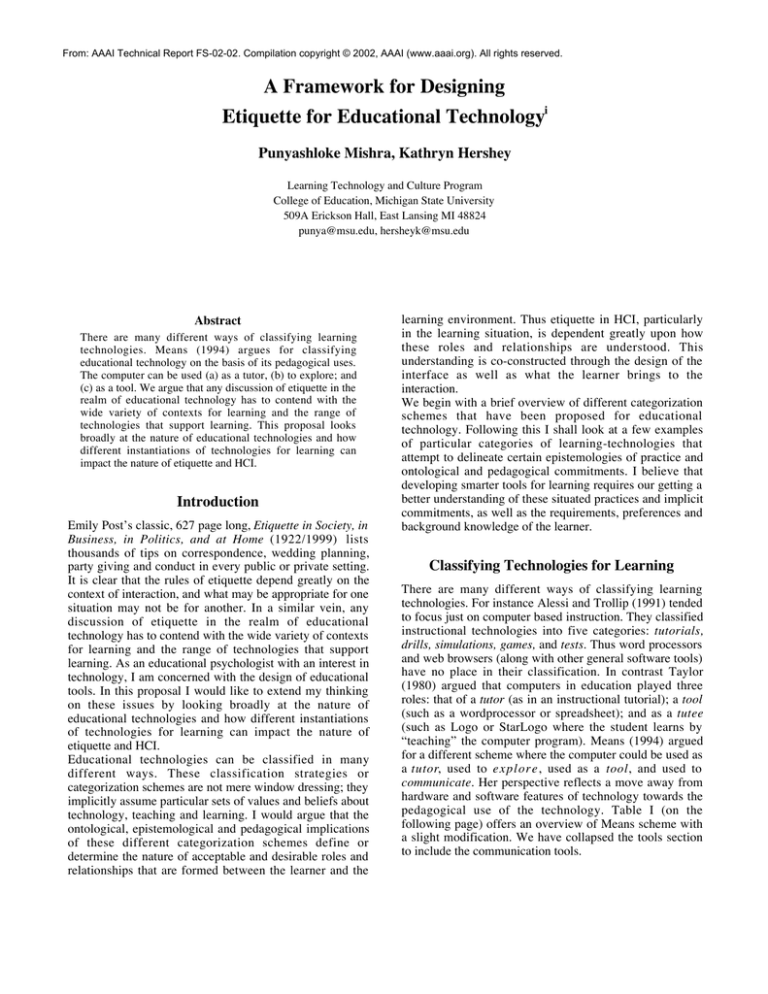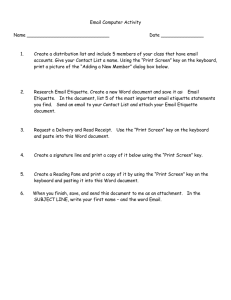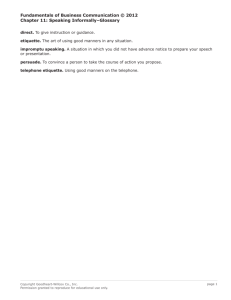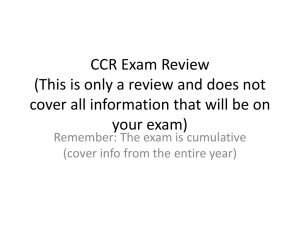
From: AAAI Technical Report FS-02-02. Compilation copyright © 2002, AAAI (www.aaai.org). All rights reserved.
A Framework for Designing
Etiquette for Educational Technologyi
Punyashloke Mishra, Kathryn Hershey
Learning Technology and Culture Program
College of Education, Michigan State University
509A Erickson Hall, East Lansing MI 48824
punya@msu.edu, hersheyk@msu.edu
Abstract
There are many different ways of classifying learning
technologies. Means (1994) argues for classifying
educational technology on the basis of its pedagogical uses.
The computer can be used (a) as a tutor, (b) to explore; and
(c) as a tool. We argue that any discussion of etiquette in the
realm of educational technology has to contend with the
wide variety of contexts for learning and the range of
technologies that support learning. This proposal looks
broadly at the nature of educational technologies and how
different instantiations of technologies for learning can
impact the nature of etiquette and HCI.
Introduction
Emily Post’s classic, 627 page long, Etiquette in Society, in
Business, in Politics, and at Home (1922/1999) lists
thousands of tips on correspondence, wedding planning,
party giving and conduct in every public or private setting.
It is clear that the rules of etiquette depend greatly on the
context of interaction, and what may be appropriate for one
situation may not be for another. In a similar vein, any
discussion of etiquette in the realm of educational
technology has to contend with the wide variety of contexts
for learning and the range of technologies that support
learning. As an educational psychologist with an interest in
technology, I am concerned with the design of educational
tools. In this proposal I would like to extend my thinking
on these issues by looking broadly at the nature of
educational technologies and how different instantiations
of technologies for learning can impact the nature of
etiquette and HCI.
Educational technologies can be classified in many
different ways. These classification strategies or
categorization schemes are not mere window dressing; they
implicitly assume particular sets of values and beliefs about
technology, teaching and learning. I would argue that the
ontological, epistemological and pedagogical implications
of these different categorization schemes define or
determine the nature of acceptable and desirable roles and
relationships that are formed between the learner and the
learning environment. Thus etiquette in HCI, particularly
in the learning situation, is dependent greatly upon how
these roles and relationships are understood. This
understanding is co-constructed through the design of the
interface as well as what the learner brings to the
interaction.
We begin with a brief overview of different categorization
schemes that have been proposed for educational
technology. Following this I shall look at a few examples
of particular categories of learning-technologies that
attempt to delineate certain epistemologies of practice and
ontological and pedagogical commitments. I believe that
developing smarter tools for learning requires our getting a
better understanding of these situated practices and implicit
commitments, as well as the requirements, preferences and
background knowledge of the learner.
Classifying Technologies for Learning
There are many different ways of classifying learning
technologies. For instance Alessi and Trollip (1991) tended
to focus just on computer based instruction. They classified
instructional technologies into five categories: tutorials,
drills, simulations, games, and tests. Thus word processors
and web browsers (along with other general software tools)
have no place in their classification. In contrast Taylor
(1980) argued that computers in education played three
roles: that of a tutor (as in an instructional tutorial); a tool
(such as a wordprocessor or spreadsheet); and as a tutee
(such as Logo or StarLogo where the student learns by
“teaching” the computer program). Means (1994) argued
for a different scheme where the computer could be used as
a tutor, used to explore, used as a tool, and used to
communicate. Her perspective reflects a move away from
hardware and software features of technology towards the
pedagogical use of the technology. Table I (on the
following page) offers an overview of Means scheme with
a slight modification. We have collapsed the tools section
to include the communication tools.
Further, we will consider a few examples from each of
these categories to better understand the broad outlines of
etiquette required. We shall do this by looking at the
implicit assumptions about (a) the nature of knowledge; (b)
the nature of the relationship between the learner and the
computer program; and (c) how etiquette can foster
learning in each case.
Case I: Tutorial
Tutorials assume a fixed body of knowledge that needs to
be imparted to the learner. This could be a range of things
but clearly emphasizes the acquiring of facts or skills. It is
assumed that the learner knows less of the domain than the
tutor and thus there is a greater deal of control on the part
of the tutor of how the learner traverses the given
knowledge space. To use a cliché, the computer program
becomes “a sage on a stage” delivering information to the
learner in a traditional didactic manner.
Implications for etiquette: The computer program or
interface needs to indicate that it is more knowledgeable
Category
Computer used …
… as a Tutor
… to explore
… as a tool
about the domain in question. It needs to guide students
along the desired path towards learning the facts or skills
required. The personality it needs to exhibit is more that of
a drill instructor. In terms of etiquette the interface needs to
be pliable yet firm, sensitive to the user’s knowledge state
yet always guiding the learner towards the right path. Thus
a mistake by a student would elicit some response from the
tutorial and provide the student an opportunity to rectify
their error before moving on.
Case II: Exploration
Educational technologies for exploration allow for a
greater degree of autonomy for the learner. The computer
program becomes more of an arena for intellectual play
than a site for explicit instruction. The learner is in charge
of the process, and the role of the computer program is
more to offer help as and when the student “gets lost.” The
cliché most appropriate here is that of a “guide on the side”
(as opposed to the sage on a stage).
Definition
Examples
Systems designed to teach by providing
information, demonstrations, or simulations
in a sequence determined by the system.
Tutorial systems may provide for expository
learning (the system displays a phenomenon
or procedure) and practice (the system
requires the student to answer or questions
or solve problems).
Systems designed to facilitate student
learning by providing information,
demonstrations, or simulations when
requested to do so by the student. Under
student control, the system provides the
context for discovery (or guided discovery)
of facts, concepts, or procedures.
Computer-assisted instruction (CAI),
Intelligent CAI, Instructional
television, Some videodisc/multimedia
systems
General purpose tools for accomplishing
tasks such as composition, data storage, or
data analysis including systems that allow
groups of teachers and students to send
information and data to each other through
networks and other technologies
Word processing software, spreadsheet
software, database software, desktop
publishing systems, web publishing
systems, image creation and
manipulation, video recording and
editing systems/software.
Local area networks, wide area
networks, email, Internet, WWW,
Web based learning
Microcomputer-based laboratories,
Microworlds/simulations, Some
videodisc/multimedia systems
Table I: Means’ (1984) classification of Educational Technology, with examples.
Implications for etiquette: The computer program needs to
exhibit a more friendly and co-exploratory face allowing
the learner to explore the knowledge space and yet be
willing to step out of the way when needed. It needs to
have some domain knowledge built in since most
exploratory tools (such as educational scientific
simulations) are strongly grounded in particular content
areas. There is a great deal of research on student
misconceptions in particular content areas (particularly in
science and mathematics). This knowledge could be used
to develop systems that anticipate possible student
problems and offer, unobtrusively, opportunities for
students to learn more. An example of such a system would
be the feedback process we prototyped to work with
GenScape, a biology simulation. The computer program
would send messages to the students when they did
something that was perceived as being incorrect. The
student, however, could ignore this feedback and continue
with their exploration if he or she so desired.
Case III: Tools
It would appear that generic tools such as wordprocessors
and spreadsheets do not need any particular redesign (from
the etiquette point of view) when considered in the context
of learning. However it could be argued that the use of
these tools in a pedagogical context requires the
development of some different kinds of scaffolding
mechanisms. For instance, using a word processor to teach
creative writing to fifth graders requires the design of help
systems that offer students help on plot structure and
narrative while using it for writing poetry would require
help on meter and rhyme. Microsoft Word, for instance,
already comes with help designed to assist people who are
doing standard tasks such as writing letters and so on.
Implications for etiquette: The help functions in this case
need to be somewhat similar to what we described for
exploration, supportive but not in your face, with one
significant difference. Since these are generic tools
(applicable to multiple content areas) the software would
not have content specific knowledge (as in the case of
exploratory software such as simulations) though as
specific contexts emerge, this may change.
These categories are clearly not exclusive. A computer
program could very easily straddle all three of these
categories. For instance, a simulation of frog dissection
could be used as a tutorial and as an arena for exploration.
A web site could be a tutorial as well as a medium for
communication or a site for exploration. Like all
taxonomies, the boundaries between the categories are
fuzzy. However, our goal is not necessarily to come up
with a final and complete classification but rather to
suggest a framework for thinking about etiquette and how
it can play out in the design of educational technology.
It is also important to remember that there are many other
issues that play out in the design of interface etiquette. The
spread of the Internet and online education bring crosscultural issues of etiquette to the forefront as well. A
personal example may be pertinent here. Having lived and
taught for the past decade in the United States, humor has
become a very important tool that I use in my teaching. A
recent visit back to my native India drove home to me just
how different classroom norms and student expectations
can be. My attempts at humor just fell flat in Indian
classrooms, even in ones with graduate students which one
would expect to be more open to such informal dialogue.
These are issues that interface designers have not given
much consideration in the past.
That said, it is surely not the case that we do not have any
existing research on how to design etiquette for learning.
There exists an immense body of research on teacher
behavior and its effects on student motivation and learning
in human-human situations that can be brought to bear on
interface design for educational technology. For instance a
review of the literature on non-verbal teacher behavior
indicate that nonverbal behaviors like eye-contact,
gestures, vocal inflections, body movement, and
combinations of nonverbal behaviors conveying
"enthusiasm," "animation," and "variation of stimuli" can
have positive effects on students' motivation, attention,
teacher ratings, immediate recall, and achievement. Again
as the CASA research indicates, much of this existing
research on human-human interaction can help us develop
better “behaved” tools for learning.
The Merriam-Webster dictionary defines etiquette as “the
conduct or procedure required by good breeding or
prescribed by authority to be observed in social or official
life.” Clearly there is a lot of work to be done in
developing a “better breed” of educational technology. I
see this symposium as being a first step in this regard.
References
Alessi, S. M. & Trollip, S. R. 1991. Computer based instruction,
New Jersey: Prentice-Hall.
Means, B. 1994. Introduction: Using technology to advance
educational goals. In B. Means eds. Technology and education
reform: The reality behind the promise (pp. 1-21). San Francisco:
Jossey-Bass.
Post, E. 1922/1999. Etiquette in Society, in Business, in Politics
and at Home. New York: Funk & Wagnalls. Republished in
Bartleby.com www.bartleby.com/95/ [Julu 14, 2002].
Taylor, R. P. 1980. The computer in the school: Tutor, tool, tutee.
New York: Teachers College Press.
i
This work is supported by grants from the Joe and Lucy Bates Byers
Foundation and the Intramural Research Grant Program at Michigan State
University. We would like to thank Suman Mishra for her help in
developing these ideas.





